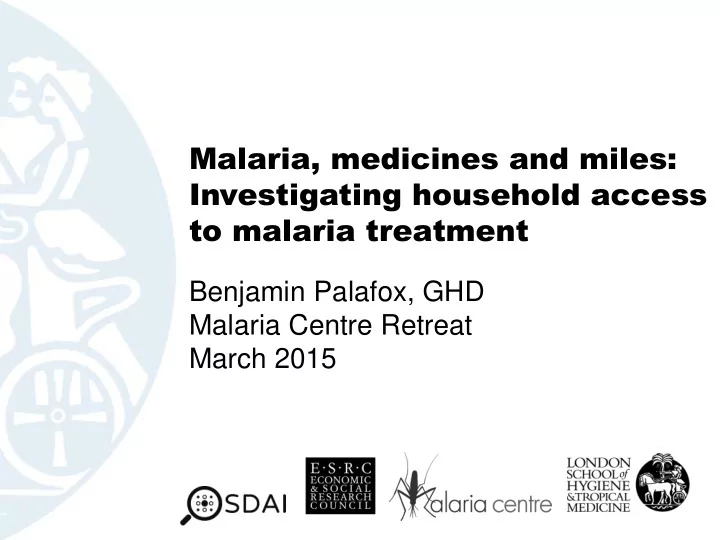

Malaria, medicines and miles: Investigating household access to malaria treatment Benjamin Palafox, GHD Malaria Centre Retreat March 2015
Background: Malaria treatment • Recommended first-line treatment: – Artemisinin-based combination therapy (ACT) – Adopted by WHO in 2005 – Resistance to non-artemisinin therapy (e.g. SP) – Bans on oral artemisinin monotherapies • Large treatment gap persists – Children with confirmed malaria who receive ACT ranges from 1% to 42%
Background: Conceptualising the ACT access gap S S U U P P P P L L Y Y D D E E M M A A N N D D
Presentation objectives 1. Describe a method of combining supply- and demand- side survey data to produce representative indicators of household access to treatment 2. Illustrate this approach to estimate supply-side access indicators using data from Benin, Nigeria, Uganda and Zambia 3. Discuss strengths and limitations of this approach and implications for policy and practice
Methods: The ACTwatch project Cambodia Nigeria Benin Uganda DRC Objective Provide policy makers with evidence on trends in availability, price, and Zambia use of antimalarials Madagascar 3 linked national surveys Households, Outlets, Supply Chains
Methods: Household and outlet surveys • National cross-sectional COUNTRY samples • 2 survey rounds per country: 2009-10 and 2011-12 • Share similar multi-stage cluster design • Included households: recently febrile child under 5 years • Include outlets: all outlets currently or recently stocking antimalarials
Methods: Household and outlet data Households: Outlets: • Treatment choices for • Availability, product details febrile children under 5 and price of all antimalarials stocked • Type, source, price paid • Provider perceptions and for treatment knowledge of antimalarials • Caregiver’s knowledge, • Availability and price of beliefs, attitudes diagnostic testing services • Household wealth index • Geographic coordinates based on assets and dwelling characteristics • Geographic coordinates
Methods: Creating the access dataset • Merge household and outlet datasets • Use geographic coordinates from households and outlets in vicinity to define treatment options available • Defining treatment option ‘catchment area’ – By distance from household different radii to define – By primary sampling unit
Methods: Defining access indicators • Treatment options reasonably accessible to households: – Radius of 5km around surveyed household – Number, types and other characteristics of treatment sources Types of antimalarials and diagnostics stocked and their prices • Basic supply-side indicators on availability – % households with reasonable access to: • Any treatment source stocking ACT • Specific treatment source types stocking ACT • National estimates account for survey design – Compared across urban and rural areas – Examine changes over time
% of households with access to ACTs vs. non-ACT within 5km ACT Only non-ACT 100 80 60 40 20 0 Base End Base End Base End Base End Base End Base End Base End Base End Urban Rural Urban Rural Urban Rural Urban Rural Benin Nigeria Uganda Zambia
% of rural households with access to ACT by source: over time Public/Non-profit facility Private facility Pharmacy Drug store General retailer 100 80 60 40 20 0 Benin Nigeria 100 80 60 40 20 0 Uganda Zambia
% of rural households with access to ACT by source: over time Public/Non-profit facility Private facility Pharmacy Drug store General retailer 100 80 60 40 20 0 Benin Nigeria 100 80 60 40 20 0 Uganda Zambia
Other indicators and applications • Price of ACT and non-ACT accessible to households • Distance to nearest treatment sources • Quality: access to microscopy and RDTs, qualified health professionals • Combined access dataset provides rich information from supply and demand perspectives – Integrated understanding of access and how to improve it – Enhance modelling determinants of treatment seeking behaviour
New approach to measure access Strengths Limitations • • Produces objective, realistic, Complementary surveys dynamic and representative must be conducted measures of access contemporaneously • • Comparable across contexts Expensive: censusing and over time: impact • Simplistic use of geospatial evaluations data • Easily scaled and transferred to other products/conditions
www.actwatch.org See our papers and reports here
Recommend
More recommend